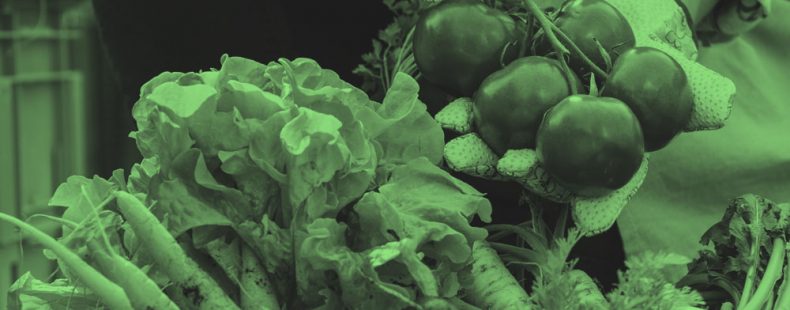Trying to classify what’s a fruit and what’s a vegetable isn’t always cut and dry. In fact, the debate about it can get pretty juicy—seedy, even. This all stems from the fact that some things we eat are technically fruits but are almost always called vegetables (and treated like vegetables, too). Some people make a distinction based on the level of sweetness, but the difference—from the perspective of a botanist, at least—is less a matter of taste and more a matter of which part of the plant you’re eating.
This article will get to the root of which foods are fruits, which are vegetables, and which are actually fruits despite always getting placed with the vegetables at the grocery store. You’ll come away with answers to these questions and more:
- What exactly is the difference between fruits and vegetables?
- Is a tomato a fruit or a vegetable?
- Is a potato a vegetable?
- Are berries fruit?
- What about nuts?
We’ll even include a list of the fruits and vegetables whose categorization status most often pits people against each other, along with their technical classification and what they’re usually considered in culinary use. (Spoilage alert: the fruit and veggie puns are already pretty ripe, but they’re going to get even grosser.)
⚡ Quick summary
Technically speaking, a fruit is a plant’s developed ovary that comes from a flower and contains one or multiple seeds. The term vegetable is much broader—it refers to any part of a plant that’s used for food, including the roots, tubers, stems, and leaves. Many of the foods that we casually call vegetables, like tomatoes, are technically fruits. Still, it’s a technical distinction that’s usually ignored in practical contexts, such as menus or the layout of the produce section.
What is the difference between a fruit and a vegetable?
To a botanist, the word fruit specifically refers to the edible part of a seed plant that develops from a flower into a ripened ovary that contains one or more seeds—fertilized seeds capable of generating a new plant. Fruits come from many different types of plants: apples grow on trees, grapes grow on vines, and blueberries grow on shrubs, for example. The botanical definition of a fruit has nothing to do with whether or not it tastes sweet.
The word vegetable tends to make us think of savory (and nonsweet) flavors. But vegetable simply means any part of a plant that is grown primarily for food. This can be the leaves (spinach), the root (carrots), the tuber (potatoes), the flower (broccoli), the stalk (celery), or other parts—including the fruit. Yes, definitionally speaking, fruits are actually just one type of vegetable (because they’re an edible part of a plant).
Learn some of the weird and uncommon names for the foods we love.
Still, people don’t usually think about their fruits and vegetables in terms of strict, definition-specific distinctions. In everyday, nonscientific contexts, we usually make the distinction between a fruit and a vegetable based on how we eat it and what dishes we put it in, especially according to whether it’s sweet or not. To most of us, fruits are the edible, usually sweet parts of a plant—often ones that are eaten raw, squeezed for juice, or used in desserts.
Many things that are technically fruits are commonly treated as vegetables (and even sometimes the other way around). Here are some whose categorizations are among the most ambiguous.
Tomato: fruit or vegetable?
It’s both. No matter how you slice it, a tomato is technically a fruit (the seed-filled ovary of the plant), but it’s typically treated as (and called) a vegetable. The classification confusion is understandable, given its savory but sweet flavor and the fact that it’s commonly used in savory dishes in the same way that vegetables usually are. Even the Supreme Court has had trouble with putting the fruit in the right category. In 1893, the high court of the US decided a tomato is a vegetable because of the way it’s used in cooking, regardless of the botanical categorization.
Just because the scientific definition is clear doesn’t mean the issue is settled. Perhaps the distinction is best summarized by the quote, often attributed to journalist Miles Kington, that “Knowledge is knowing that a tomato is a fruit. Wisdom is not putting it in a fruit salad.” But even that notion has been contradicted by countless cooks—search some variation of tomato and watermelon salad recipe and you’ll get millions of hits.
Is a cucumber a fruit?
The cucumber plant is part of the gourd family. The part that people eat (and turn into pickles) is the fruit of the plant. So while you might not think of a cucumber salad as a kind of fruit salad, cucumbers do fit the technical definition of a fruit. It’s a good reminder that taste and how people commonly prepare a food have little to do with its scientific classification.
Is a coconut a fruit?
A coconut is the fruit of the coconut palm. It falls into the subcategory of fruits called drupes, which are distinguished by an outer skin, a fleshy middle, and a hard woody shell over a single seed. However, unlike other drupes in which the flesh covering the seed is what’s eaten (like peaches or cherries), the edible part of the coconut is the meat just inside that last interior shell.
Is a potato a vegetable?
The potato is part of the same family of plants (the nightshade family) as the tomato, the eggplant, and some peppers. But unlike those, it’s classified as a vegetable because the part of the plant that’s eaten is the tuber part of the root, as opposed to the reproductive organ.
Many people asking “Is a potato a vegetable?” are really asking if they can count it as one nutritionally, like they do green vegetables. Traditionally, potatoes have been considered a starch, but they’re full of nutrients, including vitamins C, B1, B3, and B6, as well as minerals like iron, potassium, and folate.
Is a carrot a fruit?
This is an easy one—carrots are definitely vegetables, not fruits. Like potatoes, carrots are a type of root vegetable. The greens of the plant are edible, but carrots are grown for the bright orange (or purple, or white, or yellow) taproot growing underneath.
Remember, vegetables can come from all parts of the plant, be it the roots, leaves, stalks, or other parts. Keeping that in mind can be useful when sorting out whether something belongs in the vegetable category or the fruit category.
But here’s an easier way—we’ll just tell you. Produce this produce list any time there’s a rhubarb concerning edible plant facts.
Fruit vs. vegetable list
| Food | Technical Classification | But … |
|---|---|---|
| Tomato | Fruit | Usually treated as a vegetable. |
| Cucumber | Fruit | Usually treated as a vegetable. |
| Coconut | Fruit | |
| Pumpkin | Fruit | |
| Squash | Fruit | Usually treated as a vegetable. |
| Zucchini | Fruit | Usually treated as a vegetable. |
| Eggplant | Fruit | Usually treated as a vegetable. |
| Potato | Vegetable | Often distinguished from green vegetables and treated as a “starch.” |
| Carrot | Vegetable | Can be used in sweet applications, like carrot cake. |
| Olive | Fruit | |
| Peppers | Fruit | Usually treated as a vegetable. |
| Watermelon | Fruit | |
| Corn | Fruit | Usually treated as a vegetable. Still, all grains, from corn to wheat, are technically considered fruits by definition. |
| Rice | Fruit | See note above about grains. |
| Lemon (all citrus) | Fruit | |
| Pineapple | Fruit | |
| Rhubarb | Vegetable | But famously used in pies, especially alongside strawberries. |
| Avocado | Fruit | |
| Onion | Vegetable | |
| Pizza | Fruit | We’re joking, of course. The tomato sauce on pizza has been famously considered a vegetable in the context of school lunches, but if you consider what the majority of a pizza is made from, you get a different answer: the tomatoes that make up the sauce are technically a fruit, as is the wheat typically used to make the flour in the dough that’s baked to become the crust. |
Are berries fruit? What about nuts?
You might be thinking that grains are a surprising inclusion in the fruit category. They aren’t the only fruits that often get left out of the fruit conversation, either. Nuts, berries, and pods (such as peas) are also technically fruits.
A berry is a small fruit that usually has small seeds embedded, as in grapes and blueberries. Tomatoes, in fact, also fall into this group. From a botanical standpoint, only simple fruits—those that develop from a single ovary in a single flower—are berries. Still, some other fruits commonly called berries, like strawberries and raspberries, are technically aggregate fruits, meaning they develop from multiple ovaries of a single flower. Some fruits commonly classified as berries, such as the mulberry, are multiple fruits, meaning they come from the ovaries of several individual flowers.
Do you know where in the world these foods get their names?
Nuts are also simple fruits, albeit ones eaten dry. These have an edible inside that’s enclosed in a hard shell, like a chestnut or hazelnut. Some other things that we call nuts, like walnuts and almonds, aren’t nuts from a botanical perspective, but are instead the kind of fruits classified as drupes (like coconuts), since the shells are covered in a fleshy outside. Peanuts are also not nuts—they are legumes, meaning they’re technically a vegetable.
Take the Quiz: Do you know your fruits and vegetables?
Now that we’ve satisfied your hunger for fruit vs. vegetable knowledge, head over to our quiz on the topic where you can squash the competition with your zesty skills.
Lastly: We apologize if any of the fruit and veg wordplay has been too corny.














